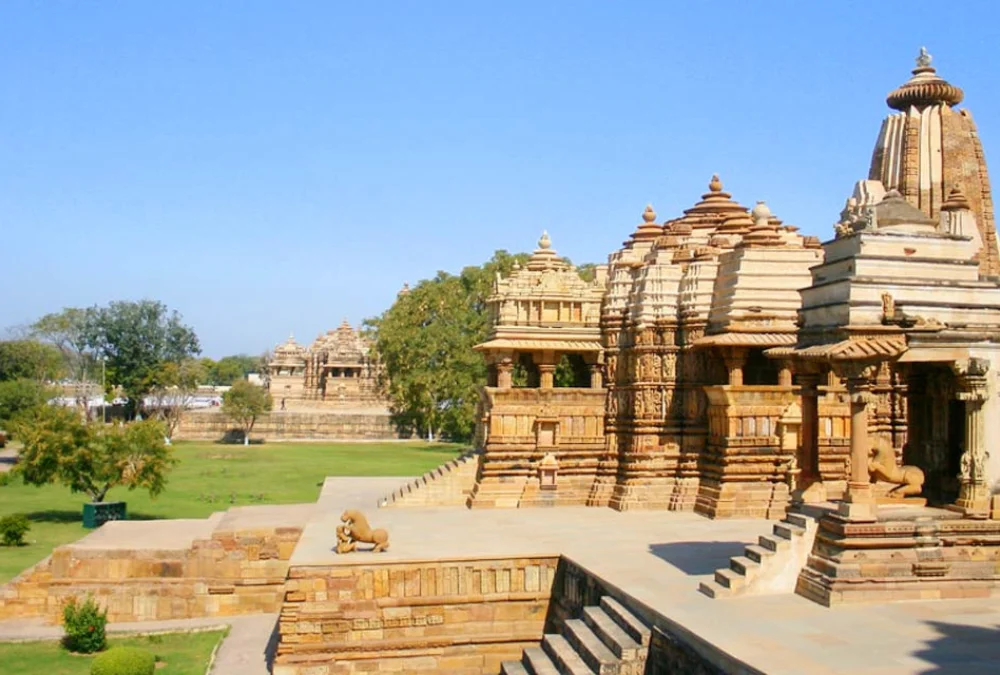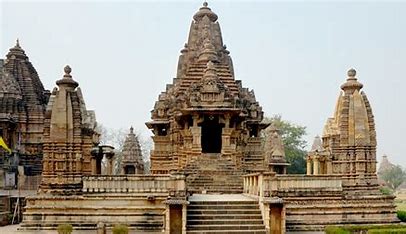Khajuraho Local Sightseeing One Day Trip By Cab
If you are planning to visit Khajuraho, one of the best ways to experience its beauty and charm is by taking a Khajuraho Local sightseeing OneDay trip by cab. A cab will allow you to travel comfortably and conveniently, without having to worry about public transportation or parking. You can also customize your itinerary according to your preferences and interests, and enjoy the flexibility and freedom of your own pace.
A typical Khajuraho local sightseeing trip by cab will cover the major attractions of the town, such as the Khajuraho Temple Complex, the Jain Temple, the Dulhadev Temple and the Chitragupta Temple. You will also get to see some of the lesser- known but equally fascinating temples, such as the Kandariya Mahadev Temple, the Lakshmana Temple, the Devi Jagdamba Temple and the Vishwanath Temple. You will be amazed by the intricate carvings and sculptures that adorn these temples and learn about the legends and stories behind them.
A Khajuraho local sightseeing Oneday trip by cab is a perfect way to discover the hidden gems of this town and make your visit memorable and enjoyable. You can book your cab online or offline, depending on your convenience and budget. You can also choose from different types of cabs, such as hatchback, sedan or SUV, depending on your group size and comfort level.
So what are you waiting for? Book your Khajuraho local sightseeing trip by cab today and get ready to witness the magic of this ancient town
overview of a Khajuraho local sightseeing trip by cab
Khajuraho is a town in Madhya Pradesh that is famous for its ancient temples that showcase the art and culture of the medieval period. The temples are renowned for their erotic sculptures that depict various aspects of human life and sexuality. Khajuraho is a UNESCO World Heritage Site and attracts millions of tourists every year who want to explore the history, architecture and spirituality of this place.
A Khajuraho local sightseeing trip by cab is a convenient and comfortable way to experience the beauty and charm of this town. You can book your cab online or offline, depending on your convenience and budget. You can also choose from different types of cabs, such as hatchback, sedan or SUV, depending on your group size and comfort level.
A typical Khajuraho local sightseeing trip by cab will cover the major attractions of the town, such as the Khajuraho Temple Complex, the Jain Temple, the Dulhadev Temple and the Chitragupta Temple. You will also get to see some of the lesser-known but equally fascinating temples, such as the Kandariya Mahadev Temple, the Lakshmana Temple, the Devi Jagdamba Temple and the Vishwanath Temple. You will be amazed by the intricate carvings and sculptures that adorn these temples, and learn about the legends and stories behind them.
Highlights of Khajuraho One day Tour by cab
Duration: Total Duration Morning 09.00 am to 5.00 pm (8 hr / 80 km). (Full-Day Khajuraho Oneday Tour By cab
Private Cab )Not Shared)
Experienced Cab Drivers.
AC Cab
Pickup & Drop From Home / Hotel From Khajuraho .
You can explore the Khajuraho Temple Complex, a UNESCO World Heritage Site that showcases the finest examples of Indian art and architecture. The complex consists of 25 temples, built between the 9th and 12th centuries by the Chandela dynasty.
You can see the Dulhadev Temple, which is dedicated to Lord Shiva. The temple is also known as the Bridegroom Temple, as it depicts Shiva as a groom with his consort Parvati.
You can end your tour with a visit to the Chitragupta Temple, which is dedicated to Chitragupta, the god of destiny and record-keeping. The temple has a unique feature of facing east, unlike most other temples in Khajuraho that face west.
You can enjoy a delicious lunch at one of the local restaurants and savor the flavors of Khajuraho cuisine.
Itinerary Of One Day Khajuraho Local Sightseeing Tour Package by Car.
The pick-up will be from Khajuraho 8.00 am and 9.00 am
Temple Name Timing/Entry Fee Recommended Duration
Khajuraho Temple 6 AM – 5 PM / Rs. 30 for Indians, Rs. 500 for Foreigners 2-3 hours
Kandarya Mahadev Temple 6 AM – 5 PM / No separate entry fee 30-45 minutes
Lakshaman Temple 6 AM – 5 PM / No separate entry fee 30-45 minutes
Jain Temple 8 AM – 6 PM / No entry fee 1-2 hours
Devi Jagdamba Temple 6 AM – 5 PM / No separate entry fee 30-45 minutes
Vishwanath Temple Khajuraho: 6 AM – 5 PM / No separate entry fee Khajuraho: 30-45 minutes
Dulhadev Temple 6 AM – 5 PM / No separate entry fee 30-45 minutes
Chitragupta Temple Khajuraho: 6 AM – 5 PM / No separate entry fee Khajuraho: 30-45 minutes
I hope this helps you plan your visit to these temples.
Your location in Khajuraho will be drop off between 5.00 pm.
Package for One day Khajuraho Local Sightseeing Trip by Private cab

Dzire/Xcent
4 Seater
Sedan
8 Hrs/80 Km
Rs.2,999/-

Ertiga
6 Seater
SUV
8 Hrs/80 Km
Rs.3,699/-

Innova / Xylo
7 Seater
SUV
8 Hrs/80 Km
Rs.4,599/-

Tempo Traveller (A/C)
17 Seater
8 Hrs/80 Km
Rs. 7,499/-
Note: Kilometer & time will be charge from garage to garage. 2) All states taxes, parking; toll & entrance fees will be charge extra. 3) Per day minimum kms run will be charge as specified city wise for outstation duty. 4) After 12 midnight 2nd day will be counted (For outstation use). 5) Driver Allowance for outstation applicable as per Day. 6) Tax will be charge on actual bill as applicable
Book Now Pune Local Sightseeing
What Is Including and Excluding In One Day Khajuraho Local Sightseeing Trip by cab?
Including Package
Pick-Up And Drop From Hotel Or Home
Selected Cab Charges.
Driver Charges.
Toll Charges.
Parking Charges.
Excluding Package
Multiple Pickup And Drop.
Accommodation.
Food (Lunch, Breakfast, or any Food.)
Entry Fee. (Some Places Charge Entry Fee.
How to Book One day Khajuraho Local Sightseeing Trip package by Cab.
The following cab service providers are planning One day Khajuraho Sightseeing Trip. You can contact them, ask for information, and book a One Day Trip for you
Itinerary of One Day Khajuraho Local Sightseeing Trip By Cab

Khajuraho Temple, visit during Khajuraho Local Sightseeing Trip by cba
Khajuraho Temple is a complex of 25 temples, built between the 9th and 12th centuries by the Chandela dynasty. The temples are famous for their erotic sculptures that depict various aspects of human life and sexuality. Khajuraho Temple is a UNESCO World Heritage Site and one of the most popular tourist attractions in India.
Location
Khajuraho Temple is located in the town of Khajuraho, in the Chhatarpur district of Madhya Pradesh, India. The nearest airport is Khajuraho Airport, which is about 6 km away from the temple complex. The nearest railway station is Khajuraho Railway Station, which is about 9 km away from the temple complex.
Timing/Entry Fees
Khajuraho Temple is open from 6 AM to 5 PM every day. The entry fee for Indians is Rs. 30 and for foreigners is Rs. 500. There is no separate entry fee for individual temples within the complex.
Things to Do
Admire the intricate carvings and sculptures that adorn the temples, and learn about the history and culture of the region.
Visit the Kandariya Mahadev Temple, the largest and most magnificent temple in the complex, which is dedicated to Lord Shiva and has over 800 sculptures of gods, goddesses, celestial beings and erotic figures.
Visit the Lakshmana Temple, one of the oldest and best-preserved temples in the complex, which is dedicated to Lord Vishnu and has a stunning image of Vishnu with four arms.
Visit the Devi Jagdamba Temple, one of the most beautiful and elegant temples in the complex, which is dedicated to Goddess Parvati and has a captivating image of Parvati as Jagdamba (Mother of the Universe).
Visit the Vishwanath Temple, one of the most impressive temples in the complex, which is dedicated to Lord Shiva and has a majestic image of Shiva’s bull Nandi at the entrance.
Visit the Jain Temple, also known as the Parsvanath Temple, which is dedicated to the Jain Tirthankaras, or spiritual leaders. The temple has a serene atmosphere and exquisite sculptures of celestial beings, animals and plants.
Must See
Visit the Dulhadev Temple, also known as the Bridegroom Temple, which is dedicated to Lord Shiva and depicts Shiva as a groom with his consort Parvati. The temple has a simple and elegant design and fine sculptures of apsaras (nymphs) and sura-sundaris (celestial beauties).
Visit the Chitragupta Temple, which is dedicated to Chitragupta, the god of destiny and record-keeping. The Khajuraho Temple has a unique feature of facing east, unlike most other temples in Khajuraho that face west. The Khajuraho Temple has a magnificent image of Chitragupta holding a pen and a book in his hands.
Enjoy a light and sound show at the temple complex in the evening, which narrates the history and legends of Khajuraho in an enchanting way.
Enjoy a delicious lunch at one of the local restaurants and savor the flavors of Khajuraho cuisine. You can try some of the specialties such as korma, dal bafla, poha, jalebi and lassi.
Significance
Khajuraho Temple is a significant example of Indian art and architecture that reflects the rich cultural heritage of India. The temples are a testimony to the artistic genius and religious tolerance of the Chandela dynasty, who built them as a tribute to their gods and goddesses. The temples are also a symbol of human expression and creativity, as they depict various aspects of human life and sexuality in a candid and realistic way. Khajuraho Temple is a masterpiece of Indian civilization that inspires awe and admiration among visitors from all over the world
Kandariya Mahadev Temple
Kandariya Mahadev Temple is the largest and most magnificent temple in the Khajuraho Temple Complex. The temple is dedicated to Lord Shiva and has over 800 sculptures of gods, goddesses, celestial beings and erotic figures. The temple is a masterpiece of Indian art and architecture that showcases the skill and creativity of the Chandela craftsmen.
Location
Kandariya Mahadev Temple is located in the western group of the Khajuraho Temple Complex, in the Chhatarpur district of Madhya Pradesh, India. The temple is situated on a high platform and dominates the skyline of Khajuraho.
Timing/Entry Fees
Kandariya Mahadev Temple is open from 6 AM to 5 PM every day. There is no separate entry fee for the temple, as it is included in the entry fee for the Khajuraho Temple Complex, which is Rs. 30 for Indians and Rs. 500 for foreigners.
Things to Do/Must See
Marvel at the main shikhara (spire) of the temple, which rises to a height of 31 meters and represents Mount Kailash, the abode of Lord Shiva.
See the garbhagriha (sanctum) of the temple, which houses a lingam (phallic symbol) of Lord Shiva, made of black marble and surrounded by four smaller shikharas.
See the mandapa (hall) of the temple, which has four porches and a large pillared hall with a pyramidal roof. The hall has some of the finest sculptures of Khajuraho, depicting various scenes from Hindu mythology and erotic art.
See the ardhamandapa (antechamber) of the temple, which has a beautiful torana (archway) with an image of Shiva and Parvati on a swing. The archway also has sculptures of musicians, dancers and lovers.
Significance
Kandariya Mahadev Temple is a significant example of Indian art and architecture that reflects the rich cultural heritage of India. The temple is a testimony to the artistic genius and religious tolerance of the Chandela dynasty, who built it as a tribute to Lord Shiva. The temple is also a symbol of human expression and creativity, as it depicts various aspects of human life and sexuality in a candid and realistic way. Kandariya Mahadev Temple is a masterpiece of Indian civilization that inspires awe and admiration among visitors from all over the world.
Lakshmana Temple:
Lakshmana Temple visit during Khajuraho Local Sightseeing Trip
This is one of the oldest and most magnificent temples in the western group of Khajuraho monuments, a UNESCO World Heritage site. It is dedicated to Lord Vishnu and was built by the Chandela king Yashovarman in the 10th century CE. The Lakshmana temple is famous for its exquisite carvings, sculptures, and architectural beauty. The temple has a three-headed idol of Vishnu’s incarnations: Narasimha, Varaha, and Vaikuntha. The temple also has erotic sculptures depicting various aspects of human life and love
Location:
The temple is located in the western group of temples in the Khajuraho complex, near the Vishvanatha Temple and the Nandi Shrine
Timing/entry fee:
The temple is open from 6 AM to 5 PM every day and the entry fee is Rs. 30 for Indians and Rs. 500 for foreigners
Things to do/must see:
Visitors can admire the stunning carvings and sculptures on the temple walls, especially the erotic ones that depict various forms of love and passion. They can also visit the Nandi Shrine, which is located opposite the Lakshmana Temple and houses a huge statue of Nandi, the bull mount of Lord Shiva. They can also explore the other temples in the western group of Khajuraho, such as the Kandariya Mahadeva Temple, the Devi Jagdamba Temple, and the Chitragupta Temple, which are equally impressive and beautiful
Significance:
The Lakshmana Temple is one of the earliest and finest examples of Chandela temple architecture. It represents the peak of artistic excellence and cultural glory of medieval India. It also showcases the religious tolerance and syncretism of the Chandela rulers, who patronized both Hinduism and Jainism. The temple is a symbol of devotion, beauty, and eroticism
Jain Temple:
This is a generic term for the temples of the Jain faith, which are found in various parts of India. Jain temples are usually built with white marble or sandstone and have elaborate carvings and sculptures. The Jain temples are also known as Derasar (in Gujarat and Rajasthan) or Basadi (in Karnataka). The Jain temples have a sanctum where the idol of a Tirthankara (a spiritual teacher) is installed, and a hall where devotees can pray and meditate. Some Jain temples also have a library where ancient texts and manuscripts are preserved. Jain temples are open to all visitors, regardless of their religion, but they have to follow certain rules such as removing their shoes, not carrying any leather items, and maintaining silence and cleanliness
Location:
There are several Jain temples in Khajuraho, mostly located in the eastern group of temples. The most prominent ones are the Parsvanath Temple, the Adinath Temple, and the Shantinath Temple
Timing/entry fee:
The Jain temples are open from 6 AM to 5 PM every day and there is no entry fee for visiting them. However, donations are welcome
Things to do/must see:
Visitors can admire the intricate carvings and sculptures on the Jain temples, which depict various scenes from Jain mythology, history, and philosophy. They can also learn about the principles and practices of Jainism, such as non-violence, truthfulness, non-attachment, and self-control. They can also witness the rituals and ceremonies performed by the Jain monks and nuns, such as puja (worship), aarti (offering of light), abhishek (bathing of idols), and paryushan (annual festival of fasting and forgiveness)
Significance:
The Jain temples in Khajuraho are among the oldest and most important pilgrimage sites for Jains in India. They reflect the rich cultural heritage and diversity of Jainism, which is one of the oldest religions in the world. They also demonstrate the harmony and coexistence between different faiths in Khajuraho, as they were built by the same Chandela rulers who built the Hindu temples. The Jain temples are a source of inspiration and guidance for millions of Jains across the world
They can also see the image of Nandi, which is one of the largest and finest sculptures of Khajuraho, measuring 2.2 meters in height and 4.5 meters in length. The image of Nandi is carve with intricate details and expressions, and is consider as a masterpiece of Indian art.
They can also explore the other temples in the western group of Khajuraho, such as the Kandariya Mahadeva Temple, the Lakshmana Temple, and the Chitragupta Temple, which are equally impressive and beautiful.
Significance:
The Vishwanath Temple is one of the most important temples in Khajuraho, as it is dedicate to Shiva, who is revere as the supreme god and the destroyer of evil. The Jain Temple also represents the concept of Shiva-Shakti (male-female) duality, which is essential for creation and harmony. The Jain Temple also showcases the artistic excellence and cultural glory of medieval India. The temple is a symbol of devotion, power, and eroticism.
Dulhadev Temple:
This is another elegant temple in the southern group of Khajuraho monuments, dedicated to Shiva. The temple is also know as the Bridegroom Temple, as it depicts Shiva as a groom with his consort Parvati. The Dulhadev Temple has a simple and graceful design, with a shikhara (spire) rising above the sanctum. The Dulhadev Temple also has some fine sculptures of apsaras (nymphs) and sura-sundaris (celestial beauties).
Location:
The temple is located in the southern group of temples in the Khajuraho complex, near the Chausath Yogini Temple and the Beejamandal Temple.
Timing/entry fee:
The temple is open from 6 AM to 5 PM every day and there is no entry fee for visiting it.
Things to do/must see:
Visitors can admire the simple and elegant architecture of the temple, which contrasts with the elaborate and ornate temples of the western group. You can also see the image of Shiva and Parvati in the sanctum, which is carve with delicate details and expressions. They can also see the sculptures of apsaras and sura-sundaris on the walls and pillars of the temple, which depict various forms of beauty and grace. You can also explore the other temples in the southern group of Khajuraho, such as the Chausath Yogini Temple, which is one of the oldest temples in Khajuraho and dedicated to 64 female yogis, and the Beejamandal Temple, which is a ruined temple that has some interesting sculptures and carvings.
Significance:
The Dulhadev Temple is one of the last temples build by the Chandela dynasty in Khajuraho. It represents the decline of their power and influence, as well as their artistic style. The Dulhadev Temple also represents the concept of Shiva-Parvati (husband-wife) relationship, which is based on love, respect, and devotion. temple also showcases. Dulhadev Temple also showcases the artistic excellence and cultural glory of medieval India. The temple is a symbol of devotion, beauty, and eroticism.
Chitragupta Temple:
Chitragupta Temple visit during Khajuraho Local Sightseeing Trip By cab
This is another impressive temple in the western group of Khajuraho monuments, dedicated to Chitragupta, the god of destiny and record-keeping. The temple has a unique feature of facing east, unlike most other temples in Khajuraho that face west. The temple has a magnificent image of Chitragupta holding a pen and a book in his hands. Chitragupta Temple also has some stunning sculptures of Vishnu, Brahma, Indra and other gods and goddesses.
Location:
The temple is located in the western group of temples in the Khajuraho complex, near the Vishvanatha Temple and the Lakshmana Temple.
Timing/entry fee:
The temple is open from 6 AM to 5 PM every day and the entry fee is Rs. 30 for Indians and Rs. 500 for foreigners.
Things to do/must see:
Visitors can admire the intricate carvings and sculptures on the temple walls, which depict various scenes from Hindu mythology, such as Vishnu’s incarnations, Brahma’s creation, Indra’s heaven, and Chitragupta’s judgment. They can also see the image of Chitragupta, which is one of the rarest and finest examples of Khajuraho art. They can also explore the other temples in the western group of Khajuraho, such as the Kandariya Mahadeva Temple, the Lakshmana Temple, and the Devi Jagadamba Temple, which are equally impressive and beautiful.
Significance:
The Chitragupta Temple is one of the most important temples in Khajuraho, as it is dedicated to Chitragupta, who is believed to be the accountant of karma and the recorder of deeds. Chitragupta Temple also represents the concept of dharma (duty) and karma (action), which are essential for human life and salvation. Chitragupta Temple also showcases the artistic excellence and cultural glory of medieval India. The temple is a symbol of justice, wisdom, and eroticism.



